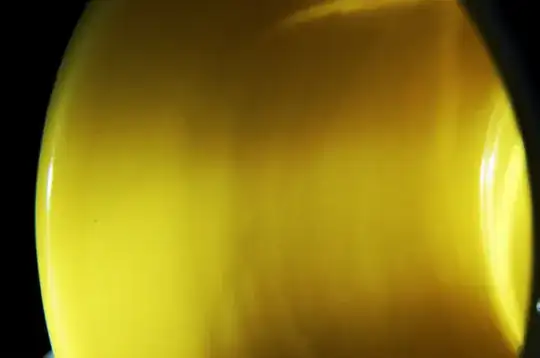I have a large ceramic soup cup which appears to be internally damaged after being rinsed with cold water while hot:

Is this cup still safe to use, or is it likely to shatter or otherwise fail during use?
I have a large ceramic soup cup which appears to be internally damaged after being rinsed with cold water while hot:

Is this cup still safe to use, or is it likely to shatter or otherwise fail during use?
That is called crazing. It is a crack or fissure in the enamel coating on the cup, not indicative of deep structural flaws.
Your cup is unlikely to fail in the sense of completely breaking due to the craze in the glaze.
On the other hand, they will stain over time, and be unsightly, and hard to wash out.
If the piece is old enough, the glaze may contain lead, which can leach due to the crazing. In that case, the piece should definitely be discarded.
Technically, most health codes require crazed dishware to be discarded, although you can assess your tolerance for risk.
potter of 28 years experience here. What you are seeing is called crazing. It's caused by a slightly poor "fit" between glaze and clay body of the ceramics, usually because of too much silica in the glaze. With some glazes, it's intentional; celedons craze, as do white raku glazes.
What you're seeing there is unintentional crazing. It's fairly common for this to appear at the first time you use it with a hot liquid, or microwave it. What's happened is that the glaze is 1% smaller than the clay body, so the first time it heats and cools, it crackles.
Whether or not eating off of crazed glazes is a health hazard is a matter of some debate. It's prohibited for most restaurants in countries with strong sanitary regulations, although rarely enforced. For home use, I personally wouldn't worry about it; you pick up more bacteria off your kitchen counter than you will from the cracks. There's one exception to this though: if the dish is low-fire earthenware, or made from a clay that was not fully vitrified, then the cracks can allow the underlying clay to absorb liquid. In addition to being a bacteria hazard, such absorbed liquid could cause (for example) the dish to explode in the microwave.
Looks crazed. Sometimes that's a death sentence for a cup, more often it means that dark colored liquids can seep into the cracks, and make things look interesting. Sometimes not even that happens, and you just have a cup with an interesting pattern in the glaze.
It is safe to use. I have seen lots of cups with similar cracks. I think that they are only in the glaze, not in the ceramic below. But even if the ceramic is slightly damaged too, I have never had one of these break in my hands despite using them for years.
As anybody who has ever made something from ceramic and has tried to paint it knows, ceramic is a very porous material, which will soak up some of whatever touches it's surface. That is the very reason why a glazing is needed to seal it, in order to make it food safe, if we want to make something, such as a cup, from it. If that ceramic cup were to be left unglazed, it would soak up some of whatever is put into it and we would never be able to clean it all out. Whatever is soaked into the ceramic, would then grow mold, trap bacteria and so become a health hazard. That is the reason why most health codes require any ceramics used to serve food or drink, to people, to discard crazed ceramics. The crazing (cracks in the glass sealing the ceramic) in a cup, does not give us cause for concern that the cup might break and spill hot liquid onto a person, because that will not happen, due to crazing alone. Crazing is simply cracks in the glazing that seals the ceramic beneath it, thus rendering it a health hazard to anybody drinking from it. We should be careful to never discount a health code, as rediculous, simply because we may not understand the reason(s) behind it. Those rules haven't been arbitrarily thought up to create a hassle, or hardship, for people serving food. They have been created to protect us, for a verifiable reason, from a danger to our health.
Cracks in any dishes hold bacteria so they are always unsafe. Never use dishes with any cracks in them for food. Chips on edges of plates or serving dishes do not really present a problem, but all tiny cracks present a health problem and the poster is also exactly right about leaching into the cracks and molds and staining resulting. If dishes have any cracks, even tiny crazing, you should think of them as unsafe for foods and eating, any kind of foods, even dry foods. And what is unsafe for humans is also unsafe for your pets. Bacteria that you do not know about can be deadly. That is why it is important for human animals and pet animals to eat cooked foods.